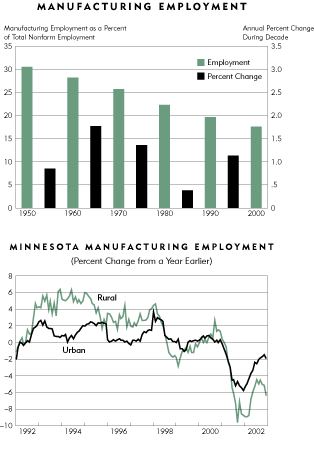The recession in the U.S. economy during 2001 hit the manufacturing sector hard nationally and in the Ninth District. Over 117,000 district manufacturing jobs were lost between the sector's peak in August 2000 and December 2002, a 4.4 percent annual decrease.
However, recent declines in manufacturing employment come in the context of an industry that has displayed soft employment growth for decades. Manufacturing employment hasn't kept pace with overall employment. From 1950 to 2000 district manufacturing employment increased 1.1 percent at an annual rate, while total nonfarm employment increased at a 2.2 percent annual rate. In addition, the percent share of district manufacturing employment as a percent of total nonfarm employment decreased from 30 percent in 1950 to 17.5 percent in 2000.
Some have expressed concern that recent declines in manufacturing employment have hurt firms in rural areas more than manufacturers in urban areas. However, recent decreases in district manufacturing employment were generally spread evenly among urban and rural areas. (Based on manufacturing employment numbers for district states and metropolitan statistical areas (MSAs), two-thirds of manufacturing jobs were located in MSAs during 2000.)

Source: U.S. Bureau of Labor Statistics
From the mid-1990s through 2002, manufacturing employment in urban and rural areas increased and decreased at similar rates in all states, except Minnesota where non-MSA employment grew about 3 percent faster than manufacturing employment in MSAs from 1991 to 1997. However, from mid-2001 to 2002 manufacturing employment in rural Minnesota decreased about 4 percent more than MSA manufacturing employment.
Specific industries that followed the overall Minnesota trend in urban/rural manufacturing employment include fabricated metal products, industrial machinery and equipment, instruments and related products, paper and allied products, and rubber and miscellaneous plastic products. All of these industries demonstrated stronger growth in rural manufacturing employment compared with MSAs in the mid-1990s and deeper rates of decline in mid-2001 through 2002.
Eva Lassemo, research assistant, contributed to this article.





